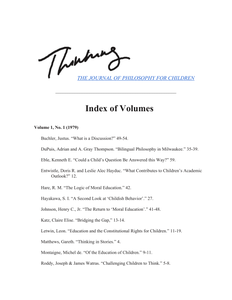The journal was a forum for the work of both theorists and practitioners of philosophical practice with children, and published such work in all forms, including philosophical argument and reflection, classroom transcripts, curricula, empirical research, and reports from the field. The journal also maintained a tradition in publishing articles in the hermeneutics of childhood, a field of intersecting disciplines including cultural studies, social history, philosophy, art, literature and psychoanalysis.
DOCUMENT

Media Do Not Exist: Performativity and Mediating Conjunctures by Jean-Marc Larrue and Marcello Vitali-Rosati offers a radically new approach to the phenomenon of mediation, proposing a new understanding that challenges the very notion of medium. It begins with a historical overview of recent developments in Western thought on mediation, especially since the mid 80s and the emergence of the disciplines of media archaeology and intermediality. While these developments are inseparable from the advent of digital technology, they have a long history. The authors trace the roots of this thought back to the dawn of philosophy. Humans interact with their environment – which includes other humans – not through media, but rather through a series of continually evolving mediations, which Larrue and Vitali-Rosati call ‘mediating conjunctures’. This observation leads them to the paradoxical argument that ‘media do not exist’. Existing theories of mediation processes remain largely influenced by a traditional understanding of media as relatively stable entities. Media Do Not Exist demonstrates the limits of this conception. The dynamics relating to mediation are the product not of a single medium, but rather of a series of mediating conjunctures. They are created by ceaselessly shifting events and interactions, blending the human and the non-human, energy, and matter.
MULTIFILE
This longitudinal, quantitative study contributes to the debate on technology-based professional development by examining the extent to which a learning (LinkedIn) intervention in a university setting affects an individual’s social media use for professional development, and the extent to which this relates to self-reported employability. In addition, we investigated how this relationship is moderated by an individual’s motivation to communicate through social media (LinkedIn). Based on social capital theory and the conservation of resources theory, we developed a set of hypotheses that were tested based on longitudinal data collected from university employees (N = 101) in middle- and high-level jobs. First, in line with our expectations, social media use for professional development was significantly higher after the learning intervention than before. Second, partially in line with our expectations, social media use for professional development was positively related with the employability dimension anticipation and optimization. Third, contrary to our expectations, motivation to communicate through social media (LinkedIn) did not have a moderating role in this relationship. We concluded that the learning intervention has the potential to foster social media use for professional development, and in turn, can contribute to individuals’ human capital in terms of their employability. Hence, the intervention that forms the core of this empirical research can be a sustainable and promising human resource management (HRM) practice that fits the human capital agenda.
DOCUMENT
